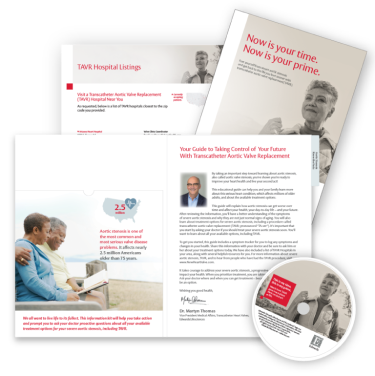For your next appointment
Use this Informed Discussion Guide to help you talk with your doctor about aortic stenosis, possible symptoms, and treatment options once your aortic stenosis becomes severe. Don’t wait.
Talk with your doctorYou may think it is ok to withhold new or worsening symptoms from your doctor at appointments, but it can be dangerous. Witholding new or worsening symptoms from your doctor at appointments can have negative consequences for your health. The symptoms may mean that your severe aortic stenosis has reached a life-threatening point.
The sooner you treat your severe aortic stenosis, the sooner you can get back to your normal life.2
Depending on how far your aortic stenosis has progressed, your doctor may prescribe medication at first to help control your symptoms. Medication alone will not treat severe aortic stenosis which will continue to get worse until you have your aortic valve replaced.9
Medication alone will not treat severe aortic stenosis. Aortic valve replacement, through either open heart surgery or the less invasive transcatheter aortic valve implantation (TAVI), which does not require your chest to be opened, is the only effective treatment for severe aortic stenosis.3
Your aortic valve replacement options:
(also known as transcatheter aortic valve implantation)
(also known as surgical aortic valve replacement)

Use this Informed Discussion Guide to help you talk with your doctor about aortic stenosis, possible symptoms, and treatment options once your aortic stenosis becomes severe. Don’t wait.
Talk with your doctorTo get the attention and care you deserve, it is important to maximize the time you have at your doctor visits. Below are some tips on how to have a helpful conversation with your doctor about your severe aortic stenosis:
Before your appointment, write down and prioritize things you want to discuss, including new or worsening symptoms, questions, and concerns you may have. Bring the list to your appointment to help focus the conversation.
Although it can be overwhelming, it is important to share changes in your health so that you can receive proper and timely care.
It is natural to feel afraid, but it is important to seek treatment for your severe aortic stenosis as soon as you experience symptoms. Postponing treatment is dangerous. Be sure to ask your doctor about all your treatment options.

Get a free information kit by email or mail to learn more about
What you’ll receive in your kit:
References
1. VahanianA, et al. EurHeart J. 2021; ehab395. doi:10.1093/eurheartj/ehab395.
2. Otto C. Timing of aortic valve surgery. Heart 2000;84(2): 211—218.
3. Brown ML, et al. J ThoracCardiovasc Surg. 2008;135(2):308—315.
4. KleczyńskiP, et al. KardiolPol. 2014;72(7):612-616.
5. Reynolds MR, et al. J Am Coll Cardiol. 2012;60(6): 548-558.
6. Mack MJ, et al. N EnglJ Med. 2019;380(18):1695–1705 and supplementary material.
7. Thourani VH, et al. Lancet. 2016;387(10034):2218–2225.
8. Leon MB, et al. N Eng J Med 2016;374(17):1609–1620.
9. Grimard, Aortic Stenosis: Diagnosis and Treatment, Am Fam Physician. 2008;78(6):717-724, 725.
10. https://my.clevelandclinic.org/health/treatments/21502-open-heart-surgery
PP--EU-7599 v1.0